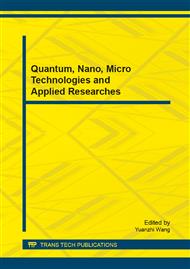p.60
p.66
p.72
p.79
p.86
p.92
p.98
p.102
p.108
Studies on the Microstructures and Properties of Broussonetia Papyrifera Fiber
Abstract:
The morphology and intrinsic properties are important factors in determining fiber processing technology and end-use performance characteristics. In this paper, a comprehensive study on structure and fundamental properties of the Broussonetia papyrifera fibers have been carried out. Morphological characteristics of Broussonetia papyrifera fibers were investigated using biological microscope and scanning electron microscope (SEM). Crystallinity and crystal structure were investigated by X-ray diffractometer. The fibers chemical components and degree of orientation were studied using infrared spectrometer instrument. Research results show that: Broussonetia papyrifera fiber possesses smooth surface and its cross striations are similar to ramies. Macromolecular crystallinity of Broussonetia papyrifera fiber is 80.57%, which is higher than that of many other natural fibers. Broussonetia papyrifera fibers orientation (65%) is close to but slightly worse than that of several other common natural fibers.This kind of fiber is Cellulose I and has almost the same components with ramie and cotton fibers.
Info:
Periodical:
Pages:
86-91
Citation:
Online since:
December 2013
Authors:
Price:
Сopyright:
© 2014 Trans Tech Publications Ltd. All Rights Reserved
Share:
Citation:


